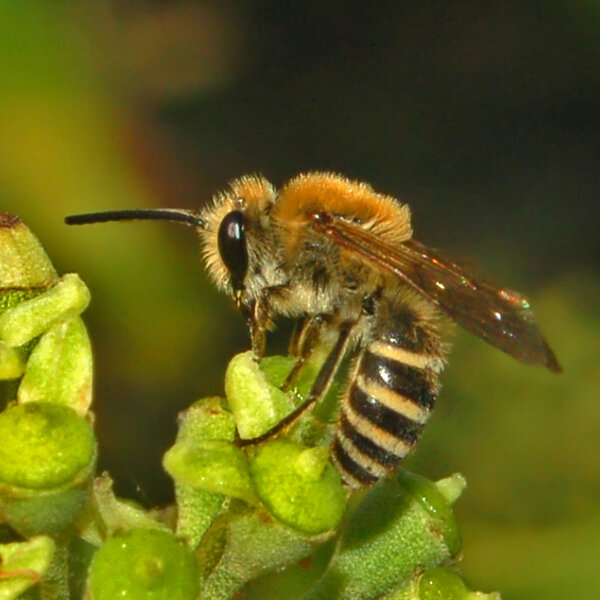Ivy Bee
Colletes hederae
The ivy bee was first recorded in the UK in 2001 so are newcomers to the British fauna. They are solitary bees with each female bee digging her own burrow in loose earth or sand. The female creates underground chambers where she will lay her eggs. She will supply the hatched grubs with pollen until she eventually dies leaving the grubs to pupate into adults. The adults will emerge in the autumn.
Ivy bees have distinctive orange/yellow striped abdomens and ginger thoraxes, and measure 8.5mm to 10mm.
What they eat
Their main food source is ivy, so can be seen in autumn when ivy is flowering. Other late flowers such as bristly oxtongue may also be visited.
Where and when to see them
They are most often seen in autumn when ivy is flowering, but are generally active from late August and into November.
They are the latest solitary bees to emerge and are relatively easy to identify as there are fewer other bees around so late in the season.
They can be spotted in urban, farmland, coastal, and heathland habitats, and often nest in large packed groups (sometimes hundreds or thousands of females nest close together). They have been recorded in southern England and Wales, but are spreading north and westwards.
View an ivy bee 10km distribution map of Wales.
Legal status
None
Similar species
Honeybee (Apis mellifera)
There is just one species of honey bee in the UK and it is identified by its sandy thorax and black abdomen with golden-amber bands. They are generally active from March to September, and live in large colonies with one queen. They can be seen anywhere with plenty of flowers including parks, gardens, woodlands, orchards and meadows. They live in a colony with one queen, and many workers and drones. They tend to live in man-made structures called hives; wild colonies are rare but may be found in hollow trees.
Common wasp (Vespula vulgaris)
Common wasps measure around 2cm long, and have very bright yellow and black bands along the body, with an obvious ‘waist’ between the thorax and abdomen. They also have an anchor-shaped mark on their faces. They are widespread and found in a variety of habitats including gardens, parks, woodland, and meadows.
Common wasps are social insects with one queen, and many drones and workers living inside a nest. The nest where the colony resides is made from chewed up wood and saliva which creates a paper-like material. Wasps have a sting to allow them to capture and immobilise their prey (such as aphids, caterpillars, flies and spiders). They will also use their sting to defend themselves or their nest.
Did you know?
The ivy bee was only described as new to science in 1993.

